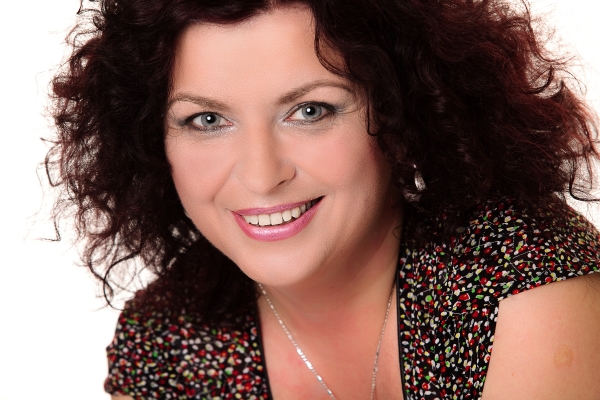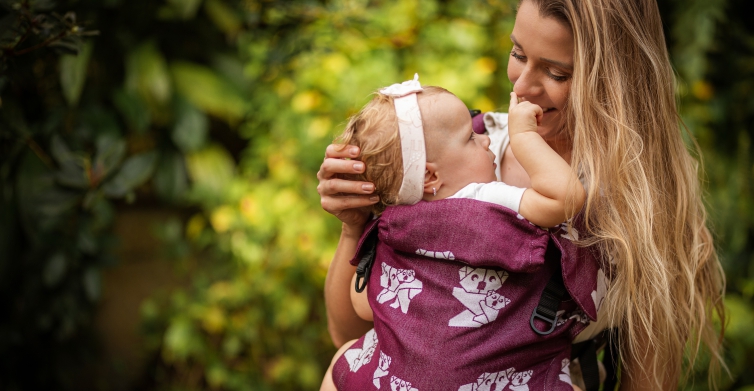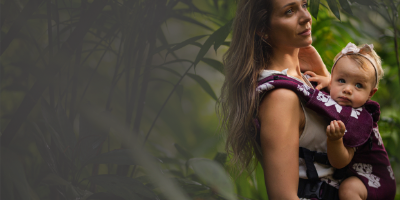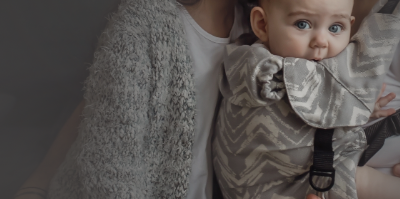Expert's Opinion
Here you can find opinions of competent persons.
A physiotherapist's point of view on Babywearing
Most people in the world carry their infants, either in their arms, in fabric, in structured carriers or even on their shoulders. Human infants, our babies, yearn (and ask) to be carried/held from birth simply because this is our biological predisposition 1,2,3,11. Among mammals we belong to the group with young - bearers (Hassenstein), who need to feel the proximity of their parents and perceive separation very negatively. Unfortunately, our infants don’t have the ability to physically hold on to us, as do apes or koalas, so they do need our help to support them on our bodies2. Babywearing has undisputable benefits for both the baby and their caregivers. Among others, babywearing helps prolong the duration of breastfeeding4, has a calming effect on the baby5, stimulates (not only) the vestibular system and strengthens the bond between mother/caregiver child2.

Although being held is our biological need, carrying our babies in our arm(s) can be quite tiring and demanding for the caregivers, more so if there are more than one child/member of the family to care for. Mothers often suffer from pain in the upper extremities (arms), shoulders and cervical area as a result of carrying their babies in one arm. Due to our sedative lifestyle and work, most of us don't have sufficient strength in our upper bodies and arms to facilitate carrying our babies throughout the day. This leads to pain and many other problems when trying to satisfy our baby's need to be carried, which can eventually even hamper our ability to physically care for them. One possible solution is to use carriers (including wraps and slings) to aid this process. In fact, they decrease the effort by at least 16%6.
Currently there are three types of babycarriers: wraps, slings and structured carriers (full buckle, half buckle, Asian style). Many parents feel that tackling a long woven wrap with a little baby may be a daunting task and opt for a structured carrier instead. There are quite a few structured carriers available on the market but unfortunately not all of them are as beneficial as I mentioned earlier. One of the most important things to note is that the baby should be facing in (facing the caregiver)7. It is also important to check the position of the legs and bottom of the baby. For ideal hip development, it is generally recommended for the hip joints to be in 100o-120o flexion and 30o – 45o abduction2,8. In fact, babywearing can be used as a tool for prevention and complimentary care of hip dysplasia8. In simple words this means that the fabric of the carrier should support baby from knee to knee and the baby should be positioned (pelvis tuck) in such a way that his knees are at least at the level of his bum (preferable a bit higher).
The newborn's spine is naturally curved in the shape of the letter C2. As the baby grows and gains control of this head and neck, the shape of the spine develops more into the shape of the letter J12. Thus, it is very important for the carrier to allow and at the same time support this natural curvature of the spine. This is especially important for the first 3-4 months or until the baby gains good control of the neck and upper torso. For this reason, it is important to choose an appropriate carrier for this stage: either a half buckle (such as Monilu Uni Tai) or a full buckle with the possibility of buckling the shoulder straps under baby's bum (such as Monilu Uni Start). It is also important that the carrier is snug against the baby from all sides and does not allow the baby to sag or collapse inside the carrier. A good way to achieve this is to use adjustable carriers that grow with the baby, such as Monilu Uni or Monilu Uni Start, as well as the use of wrap conversion carriers (all Monilu carriers are made from woven wrap fabric). Last but not least, it is important for the baby to be in close contact with the caregiver during baby wearing. This is achieved by correctly fitting and adjusting the carrier, properly tightening the straps in a half buckle or even opting for a Slim version (custom made) for caregivers with a petit size.
Contrary to what some may think, the carried child is not a passive observer2. He reacts to the movements of the wearer thus exercising his own muscles similar to what he would be doing during tummy time. There is also no time limit as to how many hours daily it is still ok to carry your child. Long term studies have shown that there is no difference in the occurrence of posture conditions in children carried a couple of hours daily and those carried for 6 or more hours2,13. These same studies show that there is no difference in the frequency of posture conditions in those that were and were not carried implying that no amount of carrying could harmfully impact the postural development of children. It should also be noted that you should not be weary of jolting or shaking the baby as our joints sufficiently absorb the impact during walking and other daily activities, definitely more than a stroller4.
Not only does correct babywearing not harm the baby, but it can also be used as a tool for prevention or even therapy of some dysfunctions or pathologies (such as the previously mentioned hip dysplasia). With the right positioning in the carrier, it is possible to aid in the therapy of scoliosis or head predilection15. Babywearing itself naturally helps prevent plagiocefalus (flattening of the head)9 and is helpful for children with the KiSS syndrome10. It also helps relax and calm babies with hypertorus dysfunctions16.
If you are unsure how to tackle a woven wrap or how to properly fit your structured carrier or perhaps have some discomfort or aches during babywearing then it’s important to seek advice from a babywearing consultant or a physiotherapist with experience in babywearing.
Mgr. Anna Motlikova
Physiotherapist and mom of two children
Resources
1: Katie Nicolai , Cache or Carry? Comparative biology and infant carrying, 2013, ,<<http://bindungtraegt.de/cache-or-carry-comparative-biology-and-infant-carrying/>>
2: Kirkilionis Evelin , A Baby Wants to be Carried : Everything you need to know about baby carriers and the benefits of babywearing, 2014, Pinter & Martin.
3: Antunovic Elizabeth, 2008, https://boba.com/blogs/boba-reads/the-second-nine-months-exterogestation-and-the-need-to-be-held
4: Pisacane A1, Continisio P, Filosa C, Tagliamonte V, Continisio GI., Use of baby carriers to increase breastfeeding duration among term infants: the effects of an educational intervention in Italy., 2012, Acta Paediatr, 101(10):e434-8
5: Esposito G1, Yoshida S, Ohnishi R, et al, Infant Calming Responses during Maternal Carrying in Humans and Mice, 2013, Current Biology, May, 6;23(9):739-45
6: Wall-Scheffler CM1, Geiger K, Steudel-Numbers KL., Infant carrying: the role of increased locomotory costs in early tool development, 2007, Am J Phys Anthropol, Jun, 33(2):841-6
7: Kirkilionis, How to carry a baby?, 2006, Mothering, 7/8, 21-23
8: Fettweis, Über das Tragen vonBabys und Kleinkindernin Tüchern oder Tragehilfen, 2010, Orthopädische Praxis, 46, 2
9: Renz-Polster, Herbert, Tragen aus kinderärztlicher Sicht, <<https://www.kinder-verstehen.de/mein-werk/artikel/tragen-aus-kinderaerztlicher-sicht/>>
10: Wuttke, Marc, Tragen und Getragen werden, <<http://www.trageportal.de/mediapool/93/935470/data/Statement_Dr._Wuttke_2011.pdf>>
11: Pohořálková, Anna, Nošení dětí na těle: pohled z perspektiv několika oborů, 2018, 6, Novorozenec, kojenec, batole, Časopis Umění fyzioterapie
12: Knowles, Rosie, Why Babywearing matters, 2016, Printer & Martin
13: Kavruk, Hilal, Der Einfluss des Tragens von Säuglingen und Kleinkindern in Tragehilfenauf die Entwicklung von Haltungsschäden im Schulkindalter–Untersuchungen mit der MediMouse®, 2010
14: Fettweis, Ewald, Dobré důvody proč nosit dítě v šátku, 2005, Deutsche Hebammenzeitschrift,12, <<http://www.didymos.cz/content/16-dobre-duvody-proc-nosit-dite-v-satku>>
15: Engel-Majer, Hilke Engel, Nošení dětí a skolióza , 2006, <<http://www.didymos.cz/content/20-noseni-deti-a-skolioza>>
16: Engel-Majer, Hilke, Discussion notes on the use of baby wrapsfrom a physiotherapeutic perspective, , <<https://www.didymos.com/content/uploads/2018/03/3_EN_Expertentexte-physiotherapeutic-point-of-view.pdf>
Baby wearing
Carrying babies in a wrap („baby wearing“) is a centuries-proven method, when millions of mothers protected the newborns and also toddlers by carrying them this way. You can note the increasing popularity of this method not only in our country lately. It is not only thanks to the practicality of the transport of nursed babies and small children, but also thanks to the support of sensuous relationship parent (mother, father) - baby and moreover it supports the proper development of the baby.
It is best ensured through the usage of certified ergonomic wrap carriers, which combine pleasure and comfort of the wrap fabric with ergonomically correct position of the baby (M-position – supporting correct development of the hip joints). The choice of the proper carrier is however utterly crucial, because there are many producers of “pseudo-ergonomic” carriers in the market. These carriers mostly made of non certified materials could on the contrary harm the baby’s development.
Baby wearing in an ergonomic position has a positive impact on the baby’s psyche itself – a close contact with the mother/father is ensured, the baby senses mother’s breath, pulse, and also rhythmical movements while walking (likewise in the prenatal period). Many studies proved that babies worn from the birth are calmer and they cry less. This is related with sooner socialization of carried babies (bigger outlook, more impulses, richer sensory perceptions, progress of the muscle tone and balance, faster learning). The carrier has to provide sufficient support of baby’s bum and thighs and a support for the head (mostly solved via the scrollable hood) for the smallest babies, eventually in case of falling asleep.
In addition carriers are very practical in light of the speed of setting (several times protected buckles) and eventual change of proportions (most of the nowadays offered carriers “grow” with your child and continually ensures the ideal position of Your baby). Carriers are very comfortable thanks to the padded straps and it can be modified to every figure.
While baby wearing we have to pay extra attention (bigger action range of the baby, falling of the parent while carrying a baby) and precisely follow the instructions for use (proper setting and usage of the carrier, enough space for breathing etc.) Parents should also bear in mind, that the baby wearing time should not exceed reasonable limit, so as further babies’ spontaneous movement activities aren’t limited (according to its developmental degree).
Ergonomic wrap carriers are a big helper of nowadays moms and the certified and checked products are benefits for the correct development of the babies from the infant age.
MoniLu carriers are in all aspect of ergonomics and the processing itself excellent and we can just recommend them.
Mgr. et Bc. Irena Pokorná







